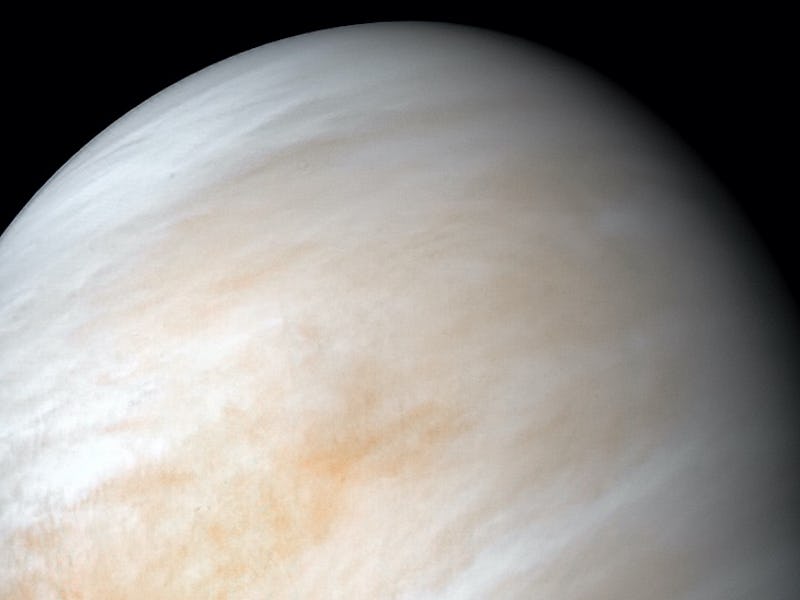Life on Venus: Rocket Lab CEO shares why we need to go "soon"
"Venus is a pretty good Earth analog for runaway climate change."

Venus, a planet close to Earth with an inferno of hot gases, could be host to a possible sign of life. The recent discovery has got some of the most important figures in private spaceflight excited.
In a study published Monday in the journal Nature Astronomy, scientists announced they detected traces of phosphine gas in the Venus atmosphere. The gas is normally associated with life on Earth. But at nearly 1,000 degrees Fahrenheit, the surface of Venus isn't exactly hospitable to life in the form we're used to – and the team can't explain how the gas got there. Lead author Jane Greaves described the discovery as "very unexpected and very exciting."
For Peter Beck, CEO of private spaceflight firm Rocket Lab, the discovery reaffirmed his focus on Venus as a destination. While SpaceX CEO Elon Musk has outlined a plan to build a city on Mars, and Blue Origin founder Jeff Bezos wants to build floating space cities, Beck has instead zeroed in on planning a trip to Venus.
"Today’s research highlights why we need to go, and soon," Beck tells Inverse.
Private interest in Venus — Breakthrough Initiatives also announced intent to look into Venus further. On Tuesday, the private space science organization, funded by Israeli-Russian investor Yuri Milner, announced plans to fund a research study into the possibility of life on the planet.
In a statement on the initiative's website, Milner stressed the importance of exploring the discovery:
“Finding life anywhere beyond Earth would be truly momentous. And if there’s a non-negligible chance that it’s right next door on Venus, exploring that possibility is an urgent priority for our civilization.”
Meanwhile, Beck has spoken before about his passion for Venus. In August 2020, he said during a livestream that he's "madly in love with Venus," with plans to host a private mission to the planet in 2023. The mission would target aerial environments around 30 miles above the surface, where conditions are closer to those found on Earth.
Peter Beck.
“I’ve always had a passion for Venus," Beck tells Inverse.
"It has long been hypothesized that its atmosphere could potentially support some kind of life, and I’ve always been eager to send a probe to find out. More than just the search for life though, Venus is a pretty good Earth analog for runaway climate change, so I believe there’s a lot we can learn from Venus’ past and apply to Earth’s future."
Venus has attracted the attention of fans interested in the emergent new space race, a race with a more prominent role for private firms. A map shared on Reddit last month showed what the planet would look like if its surface was covered in a similar amount of water to Earth. The map followed on from a previous map that applied the same treatment to Mars. Both planets have been the subject of discussion around terraforming, a human-powered transformation of the atmosphere and surface.
For now, the only Earthly visitor near Venus is Akatsuki, a Japanese space probe. It's contributed to the study of the planet's gravity waves, equatorial jet streams, and the physics of its clouds.
While Rocket Lab is one of the key firms in this new space race, Beck's focus for Venus is the Photon spacecraft. The company's satellite designs support launches to a variety of altitudes.
"About a year ago when work began in earnest on our mission to lunar orbit for NASA, we set out to design a Photon spacecraft capable of a mission to the moon, but also to Venus," Beck says. "Development of that spacecraft and mission is now well underway. The first mission to Venus will be a private one with an atmospheric probe to take a closer look at the potential for life, but it won’t be the only mission to Venus."
Read the abstract of Monday's paper below:
Measurements of trace gases in planetary atmospheres help us explore chemical conditions different to those on Earth. Our nearest neighbour, Venus, has cloud decks that are temperate but hyperacidic. Here we report the apparent presence of phosphine (PH3) gas in Venus’s atmosphere, where any phosphorus should be in oxidized forms. Single-line millimetre-waveband spectral detections (quality up to ~15σ) from the JCMT and ALMA telescopes have no other plausible identification. Atmospheric PH3 at ~20 ppb abundance is inferred. The presence of PH3 is unexplained after exhaustive study of steady-state chemistry and photochemical pathways, with no currently known abiotic production routes in Venus’s atmosphere, clouds, surface and subsurface, or from lightning, volcanic or meteoritic delivery. PH3 could originate from unknown photochemistry or geochemistry, or, by analogy with biological production of PH3 on Earth, from the presence of life. Other PH3 spectral features should be sought, while in situ cloud and surface sampling could examine sources of this gas.
Update 09/18 7 a.m. Eastern time: An earlier version of this story described Yuri Milner as a Russian investor. It has since been updated.
This article was originally published on